Shipyard named after 61 communard. Battleship "Twelve Apostles"
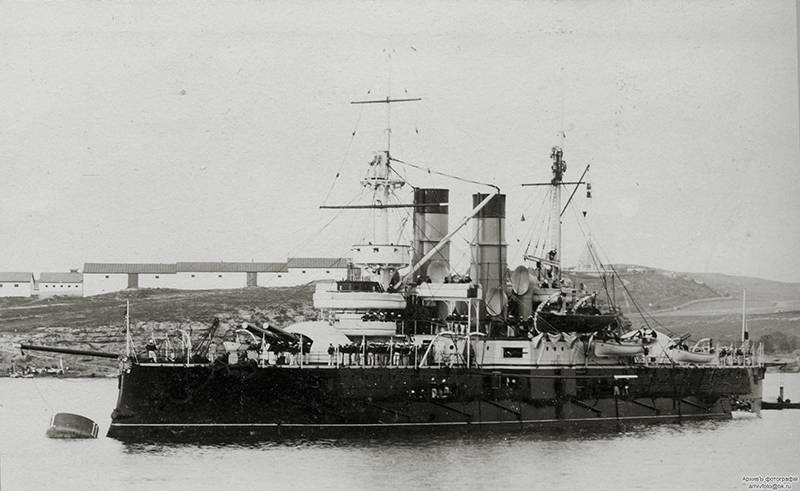
By this time, the shipyards of Nikolaev and Sevastopol had already received some experience in the construction of ships of this class and were ready for new orders. The next generation of battleships, which were supposed to be built at the Nikolaevsky Admiralty, was significantly different from its predecessors. And, of course, the fleet needed ships of other classes, since its structure was actually re-created.
Small universal armored ships in the Baltic
Striving for the most effective implementation of the fleet development program, Admiral Ivan Alekseevich Shestakov, head of the maritime department, analyzed and implemented various ideas. One of these ideas was the creation of an economy class battleship for the Baltic and European waters with a displacement of 7 – 7,5 thousand tons, which was talked about in the 1882 year. The formation of the concept of the new ship went in the spirit of hiring Mary Poppins: it was required to create the best battleship for the smallest money.
Prospective armadillos were to combine powerful weapons, sufficient booking with simultaneous compactness and "thrift" in the building. Since there were no direct analogues in foreign fleets (although Shestakov himself drew some parallels with German armored corvettes of the Saxen type and the Danish battleship of the coastal defense Helgoland), the project had to start from the basics.
Having passed a rather complicated path, which included a lot of changes, revisions, comments and suggestions, in August 1883 the project was finally approved by the Marine Technical Cabinet.
A promising economical carrier, or, as it was called in some sources, a small universal armored ship, should have a rather unusual layout. The main-caliber artillery, consisting of two 305-mm guns, was located in the nose turret. The guns themselves were mounted on special descending machine tools, similar to those installed on battleships of the Catherine II type. Space for four 229-mm and eight 152-mm guns were found in the so-called closed battery, stretching from the bow turret to the stern. The stern tower ship had not.
Instead of the idea of concentrating all the artillery in the central well-defended dungeon Shestakov, implemented on the same Danish Helgoland, Shestakov proposed an alternative concept of “throwing guns around the ship”. Due to the severe restriction on displacement, the developers had to abandon the solid armored casemate, limiting themselves with traverses and protecting small sections of the board. The space, called “closed battery” in the documentation, turned out to be generally unarmored and vulnerable to projectiles of practically any caliber.
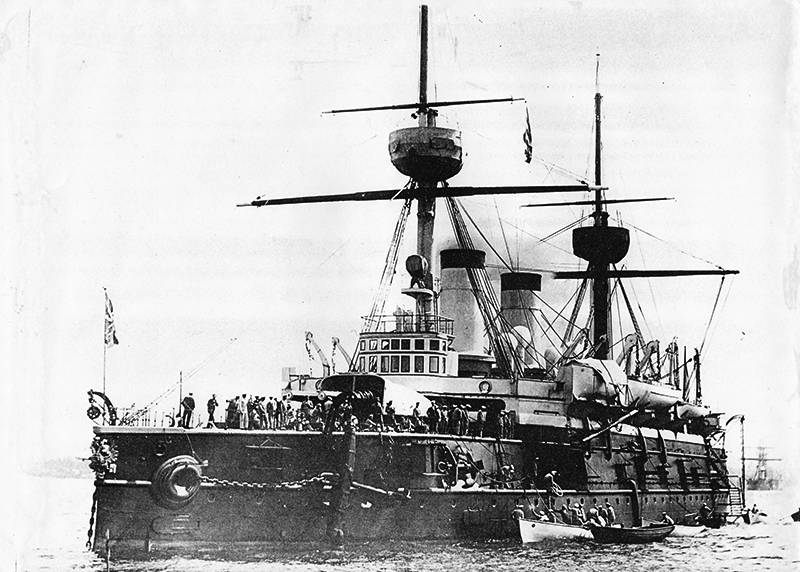
Despite all the tricks taken, the draft of the battleship increased from the preset one per meter and reached 7,01 meters. It was also not possible to keep within the framework of the initial displacement parameters, which increased by more than a thousand tons: from 7500 to 8600 t. At the same time, the ship was produced with heavily reduced coal reserves, sufficient for 4,5 autonomous navigation days instead of the planned six.
The future battleship caused controversy and discussions not only about its possible combat use, but also on issues of seaworthiness, speed and stability on the course. In this regard, the Marine Technical Committee once again raised the topic of arranging a pilot basin for testing ship models. However, Shestakov rejected the proposal because of the extra costs that the admiral found excessive.
In 1885, the project was again revised at the insistence of the restless Maritime Minister - changes were made to the reservation system and weapons. In addition, it was decided to completely abandon the originally planned sailing rig.
Due to constant adjustments and delays, the Emperor Alexander II was launched in July 1887. Before the sea trials it came only in the fall of 1890. Rear Admiral Stepan Osipovich Makarov, who took part in the tests, found the ship completely unprepared for the naval service. Launching was delayed until the year 1893, when its design was considered already obsolete.
On the basis of the technical documentation of the "Emperor Alexander II" on the instructions of Shestakov, a draft of another economy class battleship, originally conceived as a flagship, was developed. “Emperor Nicholas I” differed from its prototype by more economical machines of triple expansion and improved artillery. But the main difference between the "Emperor Nicholas I" was an impressive puke, which gave him from the stern some resemblance to a commercial steamer.

Due to the numerous alterations and changes, the descent planned for 1888 was postponed to the spring of the next 1889 year. As in the case with the previous ship, the finishing of the new battleship, which turned out to be overloaded by more than a thousand tons, was delayed. Navy wits noticed a certain similarity between the “Emperor Nicholas I” and the Volga steamships. Behind the single main-caliber single-head turret there was a massive three-story superstructure abounding with embrasures, windows and portholes. Additional superior style added solid food with two tiers of balconies, equipped with gold-plated bars.
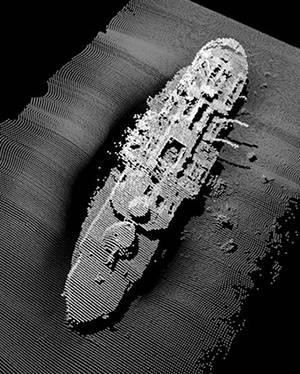
The third Baltic battleship Gangut was built according to a heavily modified project. He was somewhat smaller than the "emperors" and had different weapons from them. The Gangut was launched in October 1890 of the year, after 23 months of slipway works. Its fine-tuning and completion was delayed until the 1894 year. The ship was expectedly overloaded by almost a thousand tons, so its main highlight - the 406-mm armor belt - was hidden under water due to the increased draft.
The solution to this problem was not simple: options were being considered from all kinds of hull relief to complete re-planning of armor. However, the Baltica itself sorted out for the designers with the technical imperfections of the “Gangut” - in the 1897 year, stumbling upon an unmarked rock, the battleship sank on the inner Tranzundsky roadstead.
Fourth Black Sea
Not escaped the fashion for small battleships and the developing Black Sea Fleet. At the beginning of 1886, Admiral Shestakov visited the Nikolaev Admiralty and Sevastopol and inspected the battleships under construction there, and in April of the same year the Marine Technical Committee announced a competition for the project of the fourth battleship for the Black Sea Fleet as part of the concept of a small universal armored ship.
Displacement was determined in 7 – 8 thousand tons, and the armament was to consist of four 305-mm guns, two 229-mm guns and two 152-mm guns. The reservation requirement for the main belt is no thinner than 356 mm. For reasons of economy, it was supposed to use two steam engines from the steamer "Experience", the former imperial yacht "Livadia", built by the project of Admiral Popov, as a propulsion system.
Subsequently, the tactical and technical characteristics of the Black Sea battleship were changed: artillery from one 305-mm and four 229-mm guns were supposed to be placed in four towers.
In the spring of 1887, the Marine Technical Committee determined the winner of the competition. It was the project of the engineer Erast Evgenievich Gulyaev, a famous scientist and designer, who left a significant mark in the domestic shipbuilding.
In August of the same year, Admiral Shestakov approved the project for further work. It was supposed to build two “Gulyaev’s” battleships in the Nikolaevsky Admiralty. In September, the Maritime Technical Committee approved the theoretical design and hull specification. The fourth corps of the Black Sea battleship in its main elements was similar to the Emperor Alexander II under construction in the Baltic.
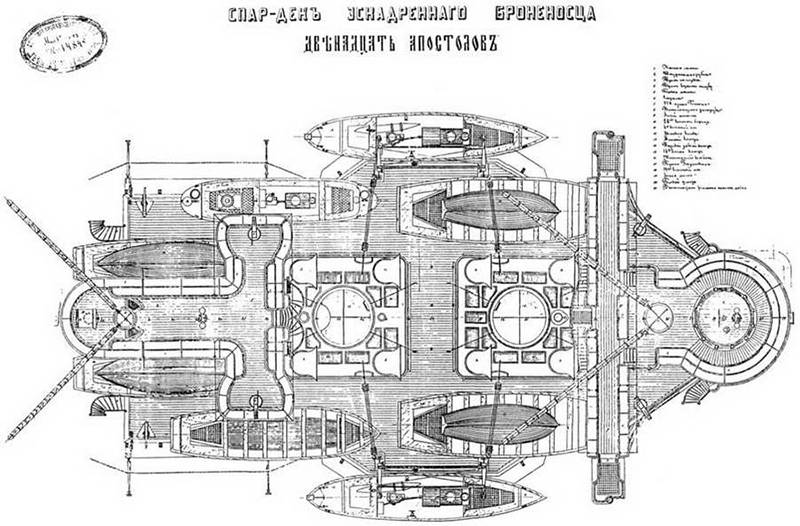
Its displacement was 8070 tons. The initial version of weapons consisted of four 229-mm 35-caliber guns in two towers in pairs and the same number of armored casemates located at the corners. In addition to them, the battleship had to have small-caliber artillery.
The decision to abandon the already traditional 305-mm guns of the main caliber was caused by the then belief in some of the advantages of 229-mm guns, in particular, in the rate of fire. In order to avoid constructive overload and at the same time keep within the permitted displacement, Shestakov allowed the reduction of the ammunition load and the abandonment of the anchor mines that the battleship should have had.
The Nikolaev Admiralty began to prepare for the construction of the second battleship after Catherine II. The management of the work, as well as the provision of working drawings, was entrusted to an experienced shipbuilder, the chief ship engineer of the Nikolaev Admiralty Colonel Saveriy Xaverievich Ratnik.
After reviewing the technical documentation on the future ship sent from St. Petersburg, the Warrior introduced a number of constructive improvements and improvements. For example, it extended the length of the main armor belt, at the same time increasing its height, replaced double boilers with single ones to save weight and space, reduced the number of chimneys from three to two. Approved by the Chief Commander of the Black Sea Fleet, Vice Admiral Peshchurov, the improvements of the Warrior were rejected by the Marine Technical Committee, since Gulyaev was able to convince everyone that everything was already quite good.
Work on the new battleship in the Nikolaevsky Admiralty began at the end of February 1888. Soon the process started with great energy was stalled. The shipyard avalanche came down difficulties and problems of an organizational and project nature. The Maritime Technical Committee, overwhelmed by an indefatigable passion for endless amendments and changes, kept the drawings sent for approval for a long time, up to several months.
Already in the middle of March, Colonel Ratnik was forced to report upstairs that he had to delay the development of many hull structure drawings, since the Maritime Technical Committee does not give any answers or orders. Such a regrettable situation, in the opinion of the Warrior, could simply disrupt the issuance of orders for steel to Bryansk Plant for the next year. The pace of work in the Nikolaevskiy admiralty steadily declined.
In addition, the Marine Technical Committee’s decision-maker, at the speed of a snail, faced another problem. The machines of the Steamer "Experience" were considered not entirely suitable for the battleship under construction. This important discovery was made no earlier than work began on the stocks. From the committee, the problem of finding a new propulsion system was transferred to the General Directorate of Shipbuilding and Supplies (GUKiS). In this institution, they pondered over the task until the end of 1888, and only then they were allowed to send out requests to the plants.
Due to the burning deadlines, it was decided to turn first to English specialists. In October, 1888 of the year, when the Warrior and the staff of the drawing workshop were waiting for documentation on the towers for 229-mm guns, new orders were received from the capital, inexpressibly “having pleased” the shipyard staff with the next impressive changes in the project. After reviewing the situation, Admiral Shestakov ordered to replace the 229-mm main-caliber guns with 305-mm guns. With a seeming gain in the rate of fire, the former did not pierce 356-mm armor plates, which was considered an unacceptable indicator.
Colonel Warrior, quickly oriented, made changes to an existing project. The battleship was now armed with four 305-mm guns and eight 152-mm anti-mine guns. In the Maritime Committee, pointing to a severe displacement limit, the number of 152-mm guns was reduced to four. The main caliber was to be located in barbetnye towers against the originally planned closed.
Meanwhile, in the Nikolaevsk admiralty itself, the situation was becoming more and more sad. In November, 1888 had to fire part of the hired workers at the shipyard in connection with the construction stop. At the end of this month, while in Sevastopol, Admiral Ivan Alekseevich Shestakov, head of the Marine Ministry, passed away. The next era of domestic shipbuilding has ended, full of experiments, both successful and unsuccessful.
At the beginning of 1889, the Marine Technical Committee suddenly remembered that the new Black Sea battleship would probably need armor, which had not yet been bother to order. Only at the end of 1889, the department ordered the required amount of armor plates to the British firm Cammel, which was already known in Russia for its work - it provided the first Russian battleship Peter the Great and the Black Sea battleships of the Catherine II type with armor. The shipments of armor were heavily delayed, and instead of the planned 1890 of the year, it was delivered to the shipyard only in 1892.
Another problem that could not be put on the shelf was the provision of a ship under construction with boilers and machines. Its solution painfully long made its way to the light through the depth of unhurried bureaucratic ice. At first, a lot of time was missed in order to come to the simple conclusion that the worn-out vehicles of the former imperial yacht are not suitable for the new battleship. Then followed a long period of awareness of this discovery, which left most of the year’s 1888. Next, the General Directorate of Shipbuilding and Supplies entered into a long-term positional correspondence with a number of British factories, but, not coming together in price, they were forced to order cars and boilers to the domestic Baltic plant.
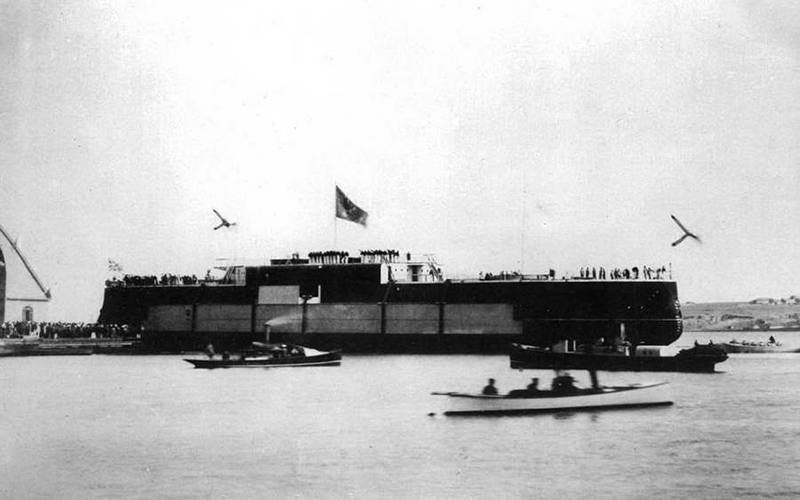
9 August 1889, the new battleship was officially laid and called the "Twelve Apostles". His descent took place on 1 on September 1890 of the year, and almost immediately the new Commander of the Black Sea Fleet, Vice Admiral Nikolai Kopytov, began the process of pushing the unfinished battleship to Sevastopol. After vigorous protests from St. Petersburg, Kopytov softened somewhat, and the Twelve Apostles continued to stand at the extension wall of the Nikolaev Admiralty.
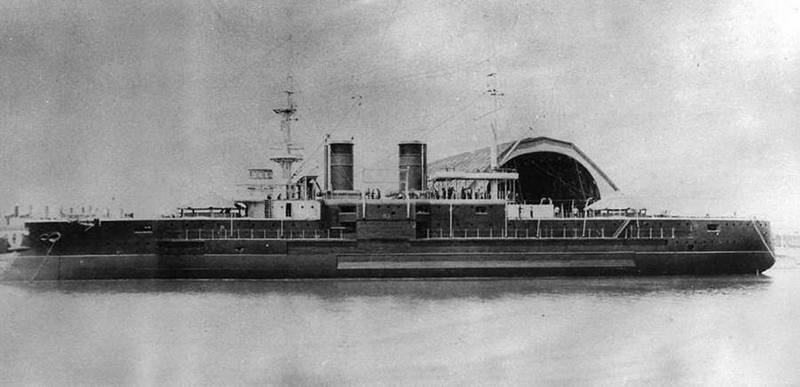
Its finishing took almost two more years, and it was only in April of the 1892 that, after hastily carried out mooring tests, a battleship with partially installed armor was transferred to the main fleet base. Debugging and bringing in a relatively combat-ready state took another two years.
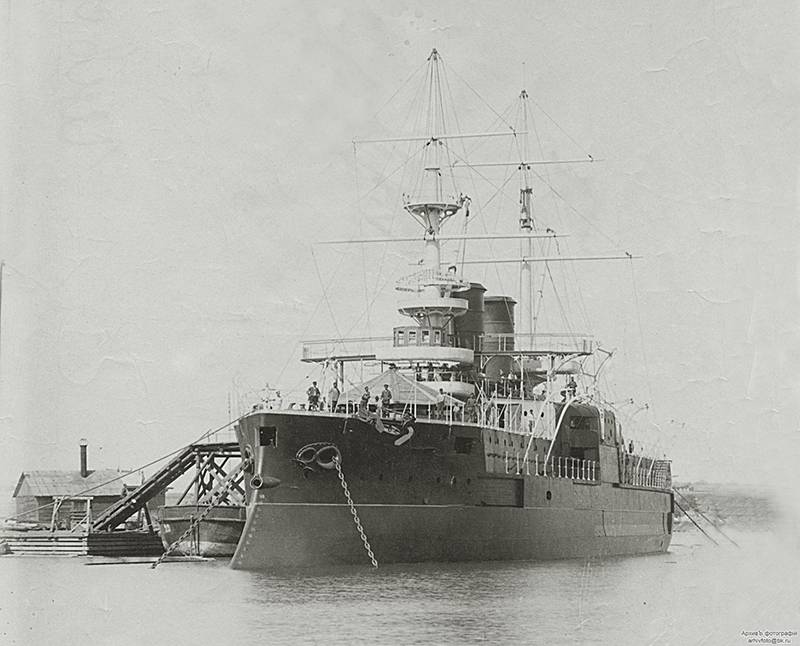
The tests showed that barbet installations could operate at roll angles of no more than 5 degrees. Nevertheless, the Twelve Apostles showed better seaworthiness than the battleships of the previous series of the Catherine II type.
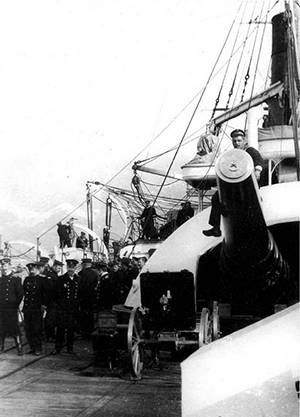
In an effort to achieve the rated power and speed, the experts of the Baltic Plant borrowed a number of technical solutions from the British. In the English fleet, cardiff, high-quality coal was used, and the forced operation of boilers was widely used. On the battleship "Twelve Apostles" this was not achieved. Forced blast systems did not work reliably, coal was of poor quality. At the official running tests, which were carefully prepared - even increased the length of both chimneys to increase thrust - rated power in 8500 l. with. reach failed. Armadillo cars issued 7951 l. with. and speed of 14,5 nodes. Acceptable performance was achieved only in almost inhuman conditions for the firemen and mechanics: by dropping all the hatches in the engine room, it was possible for a short period to give 8700 l. with. at a speed of 15,1 nodes. Of course, to achieve such results in battle was unlikely.
The service of the battleship "The Twelve Apostles" took place exclusively in unhurried, peaceful conditions, with the exception of an attempt to pacify the rebel "Prince Potemkin of Tauride", which passed without a single shot.
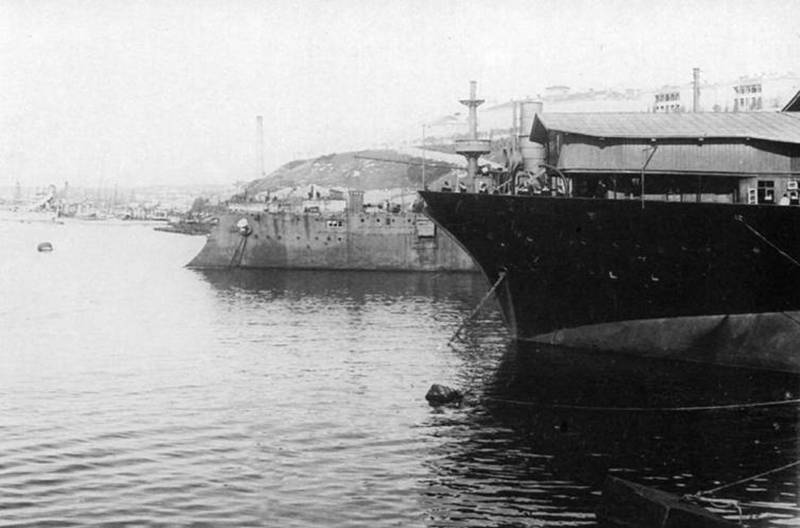
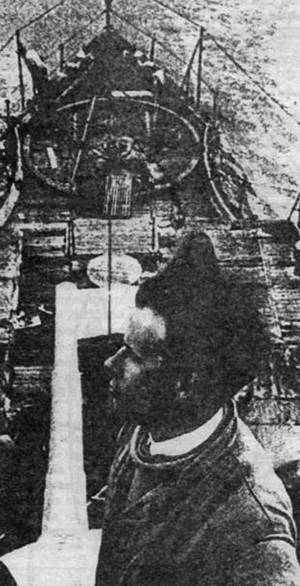
All plans for its modernization still remained unfulfilled - the stock of displacement has been completely exhausted. Along with the drawbacks, the ship had a number of advantages: smooth contours, a sturdy hull, roll and trim leveling systems - but quickly became considered obsolete. In 1911, the battleship was withdrawn from the fleet, disarmed and converted into a blockhash.
The last significant event in the life of the ship was the participation in the filming of the world-famous picture of Sergei Eisenstein's “The Battleship Potemkin”, where the Twelve Apostles played his fellow who was younger than him by 10 years. The barbet installations were very different from the Potemkin towers, and a sham was used to obtain some similarity.
At the end of 20's The former fourth battleship of the Black Sea Fleet, the Twelve Apostles, was dismantled for metal.
To be continued ...
Information